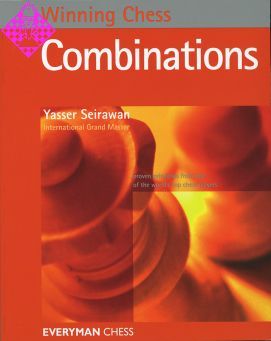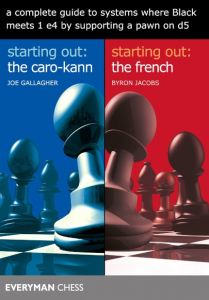Combinations are the central element in chess; they make the game so magical and captivating. The beautiful point of sacrificing a queen, the strongest piece, in order to checkmate with a lowly pawn brings a smile of joy to all chess lovers. Virtually all chess games possess a combination, either one hidden in the shadows of analysis carefully avoided or one that provides a decisive blow.
Winning Chess Combinations is a unique work that doesn't merely repeat the wonderfully rich and vast numbers of combinations, asking readers to solve a particular diagrammed position; it is a work that is far more realistic. A combination involves a sacrifice upsetting the balance of forces, but will it work or tragically boomerang? The reader is invited to solve this critical question by identifying the advantages that a specific position holds which might make the combination successful.
Winning Chess Combinations is the seventh in Yasser Seirawan's highly acclaimed Winning chess series - probably the best-selling series of chess books ever published.
·A complete guide to chess combinations
·Includes stunning sacrifices
·Ideal for the improving player
Yasser Seirawan is one of the top-ranked chess player in the USA and was the first American candidate for the World Championship title since Bobby Fischer. He is a four-time US Champion, the 1989 Western Hemisphere Champion and a ten-time member of the US Chess Olympiad team. His achievements distinguish him as one of only a handful of players to have defeated world champions Garry Kasparov and Anatoly Karpov in tournament play.
Winning Chess Combinations is a unique work that doesn't merely repeat the wonderfully rich and vast numbers of combinations, asking readers to solve a particular diagrammed position; it is a work that is far more realistic. A combination involves a sacrifice upsetting the balance of forces, but will it work or tragically boomerang? The reader is invited to solve this critical question by identifying the advantages that a specific position holds which might make the combination successful.
Winning Chess Combinations is the seventh in Yasser Seirawan's highly acclaimed Winning chess series - probably the best-selling series of chess books ever published.
·A complete guide to chess combinations
·Includes stunning sacrifices
·Ideal for the improving player
Yasser Seirawan is one of the top-ranked chess player in the USA and was the first American candidate for the World Championship title since Bobby Fischer. He is a four-time US Champion, the 1989 Western Hemisphere Champion and a ten-time member of the US Chess Olympiad team. His achievements distinguish him as one of only a handful of players to have defeated world champions Garry Kasparov and Anatoly Karpov in tournament play.
Introduction
For many years, I have wanted to write a book about chess combinations. After I learned the rules of chess, combinations were simply thrilling. As explained in Winning Chess Tactics (page 55), when shown a smothered mate featuring a Queen sacrifice I rushed home to show my mother the wonder of it all. I lost my audience quickly as she soon returned to washing the dishes. It surprised me that chess combinations aren't everyone's cup of tea. However, for those who appreciate chess the combination represents the most stunning and beautiful aspects of our wonderful game.
Unfortunately, Winning Chess Combinations, the seventh book in the series, has had to wait its turn. It has been a lengthy stint and the extra time has given me a chance for deep reflection about the kind of book that I would like to write. If not for the prodding of my publisher, Dan Addelman of Everyman Chess, this book would never have come to print. Dan was tenacious in his harping and in order to enjoy the comforts of blissful retirement I felt compelled to gather my research material and launch into writing my fourteenth book. In hindsight I am much obliged to Dan for his, ahem, gentle persuasions as I am hopeful that you, dear reader, will benefit from my efforts.
With the Winning Chess series now completed it is a good time to reflect upon what I hoped to accomplish. When planning the series in 1989 I thought to write four books. The idea was to create a kind of curriculum about chess with each work becoming progressively harder as ever more difficult concepts were introduced with each volume. Well, that at least was the plan. It failed. Within months the plan was changed. Before the envisioned four courses my publishers felt that an appetizer was needed. This preliminary work would feature chess rules and basic Information including chess notation, and would introduce the four elements of space, time, material/force and pawn structure. Hence the first book, Play WinChess, was created as the basis for future books. The four courses were intended to be Winning Chess Openings, Winning Chess Middlegames and Winning Chess Endgames. As entire books have been written on a single pawn structure, the Isolated Queen Pawn, for instance, it seemed reasonable to break the middlegame into two parts, Winning Chess Tactics and Winning Chess Strategies. Then Winning Chess Openings and Winning Chess Endings would nicely complete the banquet. Great plan. This too failed. My publishers felt that a dessert book, Winning Chess Brilliancies, should trump the endings. Winning Chess Brilliancies, would be the work that would cap all the lessons of the previous volumes and show how in the hands of the world's supreme masters the openings, strategies, tactics and endings were woven together to create masterpieces. Twelve years later six titles had been published. While Play Winning Chess was meant to be read first and Winning Chess Tactics second WinChess Brilliancies was meant to be read last. The other books could be read out of turn.
Since the series started I've been able to enjoy many letters from readers and happily correct the inevitable typos and analytical mistakes that crept into my manuscripts. Surprisingly, there was an underlying current within a large number of the letters, now electronic messages, that something was missing from the middlegame. Hadn't two books been enough? The answer was a resounding no. Readers wanted to learn more about chess combinations. As this is my favorite aspect about chess I am more than happy to oblige. My thoughts began to turn to what kind of Winning Chess Combinations book I would like to write.
With hundreds of books written about chess combinations what could I hope to write that would distinguish my work from others? I simply cannot hide my arrogance on this score and I have to say a lot. While I enjoyed many of the combination books that I've read, I found fault with them all! That is quite a statement. While all combination books are fun, showing many beautiful classical and modern combinations, the works struck me as artificial. While reading these books I realized, this is not how I played chess! Let us take a typical combinations book from a prolific author, Fred Reinfeld, 1001 Brilliant Chess Sacrifices and CombinaHere lies a marvelous example of the lazy writer's way of making a combinations book. The author makes a simple compendium of combinabroken into various themes. Readers are given 1001 chess diagram positions and you have to find the winning sacrifice for each one. Hmm. The very first thing that was wrong is that in practice I wanted to keep my pieces and sacrifice my Opponent's! The second thing that I did not like at all was that all the combinations were sound. Good grief. I should be so lucky! Many of my combinations were not winning at all. Sometimes I would take an advantageous position, uncork an appealing combination and soon be forced to accept a perpetual check. I had transformed my betposition into a forced draw. Brilliant or stupid? What about those comthat missed their mark entirely or even boomeranged owing to a hidden zwischenzug tactic or just an obvious defensive resource? Why weren't they included in Fred Reinfeld's book? Even worse, I felt that a reader of such books could hardly benefit in actual practice. After all, Fred wouldn't be there to tap me on my shoulders during a championship game and whisper to me,"Now Yasser. Now you can sacrifice a piece for a wincombination!" It seemed to me that I'd more often miss a combinathan not.
While most books on chess combinations offer good puzzles and excel at kick-starting my mental alertness, they did not in fact teach me about combinations and how to recognize their possible existence in my games. The biggest lessons appeared to be the repetitive patterns that were frequent guests. Back-rank mates, surprising double-attacks and clearance sacrifices were quite prominent. I admired the masters' ability to win with a flourish and hoped to discover the winning solution similarly. Early in my chess career winning meant mauling my opponent's entire army. Once it was suitably denuded, my thoughts turned to checkmating my oppohapless King. I was saved from such tedium when a dear friend and a chess teacher, Vladimir Pafnutieff, said to me, "Chess Combinations are the punch in chess. You have to develop your chess skills by understanding combinations. Virtually every chess game has a chess combination. You have to learn to recognize when a combination is available and you must land the blowl Ifyou do this you will win a lot of games. If not, I can teach you tennis."
Vladimir was right. Combinations are the cornerstone of a well-played chess game. Either avoiding a losing combination or creating the proper advantages necessary for a winning combination. I needed to learn to coordinate my pieces, develop rapidly and target vulnerable pieces, pawns and squares. Then maybe, just maybe, my combinations might work.
Still, I was uncomfortable with Vladimir's sage advice. Combinative play meant sacrificing and I wanted to protect my pieces and pawns. Not give them away. As the combinative genius, Mikhail Tal, said after losing the World Chess Championship title to Mikhail Botvinnik in the 1961 rematch, "My loss was a great relief to Soviet children. Now they could go back to protecting their pawns." Tal's witty insight was exactly how I felt over a decade later; I wanted to win my opponent's army while promy own. Heads up trades were okay but I worried when I was behind in the force count. My materialistic approach to chess could be summed up by a post-mortem conversation I had after a hard-played game. My opponent explained that, "In such positions the extra pawn makes no difference.'" My response was, "You may be right. But if the extra pawn makes no differgive me the difference"
When reflecting on my style, I most often considered myself to be a positional player. I like the boa-constrictor method of gaining a central advantage, limiting the mobility of my opponent and plucking pawns and misplaced pieces. An early hero of mine was the great player Tigran Petrosian, who was renowned for his careful, steady play. What surprised me was when, analyzing his games, I discovered not a dry strategist but rather a fellow who was a gifted tactician. How was this possible? Such a quiet player happily concocting strategic masterpieces could outplay the best of them in tactics. In fact, Petrosian became a chess legend for sacrificing the exchange. I began to rethink. Perhaps I wasn't so positionally monodimensional either. I began to look at my own play in a new light and discovered that I loved to attack. I was happy to sacrifice an exchange or more if my remaining forces dominated the position. My appreciation for being ahead in material actually makes me qualified to write about combinational play. My search has been for sound attacking ideas. :
Instead of creating yet another artificial construction of a combination book featuring a compendium of endless winning, sound combinations neatly sorted by theme, I've set out to write a work that is a deliberate mixture of the sophisticated and elementary. One that is far more realistic and challenging. You will not be asked merely to find a pretty solution. You'll be asked, does the diagrammed position possess a winning combiWhat advantages are there that might be enough for a successful combination? Is the obvious solution flawed? Indeed, would it boomerang against us and lose us the game? Yikes! To my way of thinking, such questions are right on the mark, as I ask myself them before sacrificing my pawns or pieces. Combinations are risky. We could lose the game, ruin our appetites and fail to enjoy the good weather. Or a cream puff may never have tasted so good after uncorking our latest brilliancy! What is it to be? Accolades of genius or bitter sweets?
The first thing we must learn is that combinations, and especially those that lead to checkmate, do not materialize out of thin air. We have to create the conditions for their successful introduction. We must establish an advantage. The easiest type of advantage for us to understand is when we are ahead in force. Our favorite living condition. From a position of supreme material superiority we can afford to be magnanimous. Yes, combicome easily when we are ahead in material. Imagine a position where we may be a pawn or two to the good with only a few pieces on the board. From a situation of material and positional superiority we sacrifice a pawn to introduce a combination that forces the trade of all the remainpieces. Then our superior King's position motors through the opponent's position vacuuming up the remaining pawns for an easy win. Sheer happiness carries us through the rest of our day. Our combination to force the trade of all the pieces worked!
A second obvious advantage is being ahead in development. We have activated our pawns and pieces, taking them from their original squares, castled, connecting our rooks, controlling the center, doing all the right things according to the rules of strategy while our opponent has been dabbling about squandering tempi. In such situations our superior, well-mobilized army overwhelms the defenders. To quote Reuben Fine, "Combinations are as natural as a baby's smile."
What I hope this book will teach is how to set the table for a successful combination. You must learn to recognize the advantages and disadvantages in a given position. Combinations spring from advantages in force, greater mobility, more space, better pawn structure, safer king, a serious weakness in our opponent's position, a misplaced piece, occupation of a vital outpost, a stable pawn wedge, better coordination of our forces, and so on. Something has to be in our favor for a combination to be sound. Chess is a game of supreme logic. It only stands to reason that we must have some advantage if our combinations may actually be correct. Yet even this is not all there is to combinations. There is a lot more, including psychology, temperament, time pressure, mood, tiredness and even laziness. Chess combinations are tactical short-term opportunities. A backmate no longer exists when our opponents create luft. A better developed army may yield a combination but if we dither the opportunity will pass us by. When we do go for it and uncork a sacrifice we immediately put pressure on our opponents. To accept the sacrifice or deftly decline the offer? It is not everyone's pleasure to be under pressure, constantly having to find the only move to stave off defeat. Many of Tal's sacrifices were unsound but time and time again his opponents cracked under the pressure of his relentless initiative. In a lecture Tal explained his approach: "/ like to take my Opponent for a walk in a dense forest. One where the path is obscure and easy to miss. I feel comfortable in such wild places." How cool is that! Sometimes we cannot be sure of the correctness of our sacriand we have to trust our fate to the chess gods. So be it! Let us develop our chess noses and learn the conditions that we need to become combinative super-stars. When we have developed the confidence of fearlessness our opponents will feel our radiating aura of confidence and they will become afraid.
Finally, I would like to give a nod of thanks to Veselin Topalov. While working on this book I was a commentator for the 2005 M-Tel Masters tournament, won by Topalov. After the tournament I thanked him, explaining that he gave me inspiration and material for three chapters! The timing was perfect for both of us.
May all your combinations be grounded on solid advantages.
Yasser Seirawan,
Seattle, Washington,
April 2006
For many years, I have wanted to write a book about chess combinations. After I learned the rules of chess, combinations were simply thrilling. As explained in Winning Chess Tactics (page 55), when shown a smothered mate featuring a Queen sacrifice I rushed home to show my mother the wonder of it all. I lost my audience quickly as she soon returned to washing the dishes. It surprised me that chess combinations aren't everyone's cup of tea. However, for those who appreciate chess the combination represents the most stunning and beautiful aspects of our wonderful game.
Unfortunately, Winning Chess Combinations, the seventh book in the series, has had to wait its turn. It has been a lengthy stint and the extra time has given me a chance for deep reflection about the kind of book that I would like to write. If not for the prodding of my publisher, Dan Addelman of Everyman Chess, this book would never have come to print. Dan was tenacious in his harping and in order to enjoy the comforts of blissful retirement I felt compelled to gather my research material and launch into writing my fourteenth book. In hindsight I am much obliged to Dan for his, ahem, gentle persuasions as I am hopeful that you, dear reader, will benefit from my efforts.
With the Winning Chess series now completed it is a good time to reflect upon what I hoped to accomplish. When planning the series in 1989 I thought to write four books. The idea was to create a kind of curriculum about chess with each work becoming progressively harder as ever more difficult concepts were introduced with each volume. Well, that at least was the plan. It failed. Within months the plan was changed. Before the envisioned four courses my publishers felt that an appetizer was needed. This preliminary work would feature chess rules and basic Information including chess notation, and would introduce the four elements of space, time, material/force and pawn structure. Hence the first book, Play WinChess, was created as the basis for future books. The four courses were intended to be Winning Chess Openings, Winning Chess Middlegames and Winning Chess Endgames. As entire books have been written on a single pawn structure, the Isolated Queen Pawn, for instance, it seemed reasonable to break the middlegame into two parts, Winning Chess Tactics and Winning Chess Strategies. Then Winning Chess Openings and Winning Chess Endings would nicely complete the banquet. Great plan. This too failed. My publishers felt that a dessert book, Winning Chess Brilliancies, should trump the endings. Winning Chess Brilliancies, would be the work that would cap all the lessons of the previous volumes and show how in the hands of the world's supreme masters the openings, strategies, tactics and endings were woven together to create masterpieces. Twelve years later six titles had been published. While Play Winning Chess was meant to be read first and Winning Chess Tactics second WinChess Brilliancies was meant to be read last. The other books could be read out of turn.
Since the series started I've been able to enjoy many letters from readers and happily correct the inevitable typos and analytical mistakes that crept into my manuscripts. Surprisingly, there was an underlying current within a large number of the letters, now electronic messages, that something was missing from the middlegame. Hadn't two books been enough? The answer was a resounding no. Readers wanted to learn more about chess combinations. As this is my favorite aspect about chess I am more than happy to oblige. My thoughts began to turn to what kind of Winning Chess Combinations book I would like to write.
With hundreds of books written about chess combinations what could I hope to write that would distinguish my work from others? I simply cannot hide my arrogance on this score and I have to say a lot. While I enjoyed many of the combination books that I've read, I found fault with them all! That is quite a statement. While all combination books are fun, showing many beautiful classical and modern combinations, the works struck me as artificial. While reading these books I realized, this is not how I played chess! Let us take a typical combinations book from a prolific author, Fred Reinfeld, 1001 Brilliant Chess Sacrifices and CombinaHere lies a marvelous example of the lazy writer's way of making a combinations book. The author makes a simple compendium of combinabroken into various themes. Readers are given 1001 chess diagram positions and you have to find the winning sacrifice for each one. Hmm. The very first thing that was wrong is that in practice I wanted to keep my pieces and sacrifice my Opponent's! The second thing that I did not like at all was that all the combinations were sound. Good grief. I should be so lucky! Many of my combinations were not winning at all. Sometimes I would take an advantageous position, uncork an appealing combination and soon be forced to accept a perpetual check. I had transformed my betposition into a forced draw. Brilliant or stupid? What about those comthat missed their mark entirely or even boomeranged owing to a hidden zwischenzug tactic or just an obvious defensive resource? Why weren't they included in Fred Reinfeld's book? Even worse, I felt that a reader of such books could hardly benefit in actual practice. After all, Fred wouldn't be there to tap me on my shoulders during a championship game and whisper to me,"Now Yasser. Now you can sacrifice a piece for a wincombination!" It seemed to me that I'd more often miss a combinathan not.
While most books on chess combinations offer good puzzles and excel at kick-starting my mental alertness, they did not in fact teach me about combinations and how to recognize their possible existence in my games. The biggest lessons appeared to be the repetitive patterns that were frequent guests. Back-rank mates, surprising double-attacks and clearance sacrifices were quite prominent. I admired the masters' ability to win with a flourish and hoped to discover the winning solution similarly. Early in my chess career winning meant mauling my opponent's entire army. Once it was suitably denuded, my thoughts turned to checkmating my oppohapless King. I was saved from such tedium when a dear friend and a chess teacher, Vladimir Pafnutieff, said to me, "Chess Combinations are the punch in chess. You have to develop your chess skills by understanding combinations. Virtually every chess game has a chess combination. You have to learn to recognize when a combination is available and you must land the blowl Ifyou do this you will win a lot of games. If not, I can teach you tennis."
Vladimir was right. Combinations are the cornerstone of a well-played chess game. Either avoiding a losing combination or creating the proper advantages necessary for a winning combination. I needed to learn to coordinate my pieces, develop rapidly and target vulnerable pieces, pawns and squares. Then maybe, just maybe, my combinations might work.
Still, I was uncomfortable with Vladimir's sage advice. Combinative play meant sacrificing and I wanted to protect my pieces and pawns. Not give them away. As the combinative genius, Mikhail Tal, said after losing the World Chess Championship title to Mikhail Botvinnik in the 1961 rematch, "My loss was a great relief to Soviet children. Now they could go back to protecting their pawns." Tal's witty insight was exactly how I felt over a decade later; I wanted to win my opponent's army while promy own. Heads up trades were okay but I worried when I was behind in the force count. My materialistic approach to chess could be summed up by a post-mortem conversation I had after a hard-played game. My opponent explained that, "In such positions the extra pawn makes no difference.'" My response was, "You may be right. But if the extra pawn makes no differgive me the difference"
When reflecting on my style, I most often considered myself to be a positional player. I like the boa-constrictor method of gaining a central advantage, limiting the mobility of my opponent and plucking pawns and misplaced pieces. An early hero of mine was the great player Tigran Petrosian, who was renowned for his careful, steady play. What surprised me was when, analyzing his games, I discovered not a dry strategist but rather a fellow who was a gifted tactician. How was this possible? Such a quiet player happily concocting strategic masterpieces could outplay the best of them in tactics. In fact, Petrosian became a chess legend for sacrificing the exchange. I began to rethink. Perhaps I wasn't so positionally monodimensional either. I began to look at my own play in a new light and discovered that I loved to attack. I was happy to sacrifice an exchange or more if my remaining forces dominated the position. My appreciation for being ahead in material actually makes me qualified to write about combinational play. My search has been for sound attacking ideas. :
Instead of creating yet another artificial construction of a combination book featuring a compendium of endless winning, sound combinations neatly sorted by theme, I've set out to write a work that is a deliberate mixture of the sophisticated and elementary. One that is far more realistic and challenging. You will not be asked merely to find a pretty solution. You'll be asked, does the diagrammed position possess a winning combiWhat advantages are there that might be enough for a successful combination? Is the obvious solution flawed? Indeed, would it boomerang against us and lose us the game? Yikes! To my way of thinking, such questions are right on the mark, as I ask myself them before sacrificing my pawns or pieces. Combinations are risky. We could lose the game, ruin our appetites and fail to enjoy the good weather. Or a cream puff may never have tasted so good after uncorking our latest brilliancy! What is it to be? Accolades of genius or bitter sweets?
The first thing we must learn is that combinations, and especially those that lead to checkmate, do not materialize out of thin air. We have to create the conditions for their successful introduction. We must establish an advantage. The easiest type of advantage for us to understand is when we are ahead in force. Our favorite living condition. From a position of supreme material superiority we can afford to be magnanimous. Yes, combicome easily when we are ahead in material. Imagine a position where we may be a pawn or two to the good with only a few pieces on the board. From a situation of material and positional superiority we sacrifice a pawn to introduce a combination that forces the trade of all the remainpieces. Then our superior King's position motors through the opponent's position vacuuming up the remaining pawns for an easy win. Sheer happiness carries us through the rest of our day. Our combination to force the trade of all the pieces worked!
A second obvious advantage is being ahead in development. We have activated our pawns and pieces, taking them from their original squares, castled, connecting our rooks, controlling the center, doing all the right things according to the rules of strategy while our opponent has been dabbling about squandering tempi. In such situations our superior, well-mobilized army overwhelms the defenders. To quote Reuben Fine, "Combinations are as natural as a baby's smile."
What I hope this book will teach is how to set the table for a successful combination. You must learn to recognize the advantages and disadvantages in a given position. Combinations spring from advantages in force, greater mobility, more space, better pawn structure, safer king, a serious weakness in our opponent's position, a misplaced piece, occupation of a vital outpost, a stable pawn wedge, better coordination of our forces, and so on. Something has to be in our favor for a combination to be sound. Chess is a game of supreme logic. It only stands to reason that we must have some advantage if our combinations may actually be correct. Yet even this is not all there is to combinations. There is a lot more, including psychology, temperament, time pressure, mood, tiredness and even laziness. Chess combinations are tactical short-term opportunities. A backmate no longer exists when our opponents create luft. A better developed army may yield a combination but if we dither the opportunity will pass us by. When we do go for it and uncork a sacrifice we immediately put pressure on our opponents. To accept the sacrifice or deftly decline the offer? It is not everyone's pleasure to be under pressure, constantly having to find the only move to stave off defeat. Many of Tal's sacrifices were unsound but time and time again his opponents cracked under the pressure of his relentless initiative. In a lecture Tal explained his approach: "/ like to take my Opponent for a walk in a dense forest. One where the path is obscure and easy to miss. I feel comfortable in such wild places." How cool is that! Sometimes we cannot be sure of the correctness of our sacriand we have to trust our fate to the chess gods. So be it! Let us develop our chess noses and learn the conditions that we need to become combinative super-stars. When we have developed the confidence of fearlessness our opponents will feel our radiating aura of confidence and they will become afraid.
Finally, I would like to give a nod of thanks to Veselin Topalov. While working on this book I was a commentator for the 2005 M-Tel Masters tournament, won by Topalov. After the tournament I thanked him, explaining that he gave me inspiration and material for three chapters! The timing was perfect for both of us.
May all your combinations be grounded on solid advantages.
Yasser Seirawan,
Seattle, Washington,
April 2006
| EAN | 9781857444209 |
|---|---|
| Gewicht | 500 g |
| Hersteller | Everyman |
| Breite | 18,7 cm |
| Höhe | 23,2 cm |
| Medium | Buch |
| Erscheinungsjahr | 2006 |
| Autor | Yasser Seirawan |
| Sprache | Englisch |
| ISBN-10 | 1857444205 |
| ISBN-13 | 9781857444209 |
| Seiten | 254 |
| Einband | kartoniert |
| Name | Everyman (former Cadogan) |
|---|---|
| Adresse | 10 Northburgh Street London EC1V 0AT Großbritannien |
| dcaddelman@yahoo.com |
Verantwortlicher Importeuer:
| Name | Schachversand Niggemann |
|---|---|
| Adresse | Schadowstraße 5 48163 Münster Deutschland |
| info@schachversand.de | |
| Internet | www.schachversand.de |
005 Introduction
012 Chapter One: Starting Out: Three Combination Types
024 Chapter Two: Checkmate! Recognizing Patterns
077 Chapter Three: The Classical Bishop Sacrifice
109 Chapter Four: The Case of the Clumsy Rook
139 Chapter Five: Blunders and Boomerangs
161 Chapter Six: Inspiring Combinations
192 Chapter Seven: Test Positions
201 Chapter Eight: Solutions
239 Summary
242 Index
012 Chapter One: Starting Out: Three Combination Types
024 Chapter Two: Checkmate! Recognizing Patterns
077 Chapter Three: The Classical Bishop Sacrifice
109 Chapter Four: The Case of the Clumsy Rook
139 Chapter Five: Blunders and Boomerangs
161 Chapter Six: Inspiring Combinations
192 Chapter Seven: Test Positions
201 Chapter Eight: Solutions
239 Summary
242 Index
Yasser Seirawans große Zeiten sind schon seit einer Weile vorbei. Ende der Achtziger zählte der smarte amerikanische Großmeister zu den besten Spielern der Welt. Ihm gelang das seltene Kunststück, in seiner Karriere sowohl gegen Kasparow als auch gegen Karpow zu gewinnen. Heute spielt er nur noch selten, wenngleich seine Elozahl von über 2600 immer noch stattlich ist. Dennoch ist er häufig bei Schachturnieren anzutreffen, allerdings meist als Kommentator, wie zuletzt in Bonn beim Kramnik gegen Deep Fritz Match. Neben seiner Kommentatorentätigkeit ist er zu einem eifrigen Schreiber geworden, der im Internet veröffentlicht und mittlerweile einige Bücher herausgebracht hat. In der Reihe Winning Chess erschien beim Everyman-Verlag über mehrere Jahre hinweg eine Serie von sieben Büchern, die sich mit allen Teilen des Schachspiels beschäftigt, von der Eröffnung bis zum Endspiel. Das letzte Buch dieser Reihe widmete sich den Combinations. Der Titel ist etwas irritierend, weil sich schon einer der früheren Bände mit Tactics beschäftigt hat. Doch während dort nur die Grundlagen dargestellt wurden, beschäftigt sich das vorliegende Werk mit komplexen taktischen Strukturen.
Seirawan verknüpft mit der Darstellung diverser Motive den Bericht seines eigenen Weges als Schachspieler, sein Scheitern und sein Meistern der Schwierigkeiten, seine Fortschritte wie seine Rückschläge. Gelegentlich zeigt er auch eigene Partien, doch eher behutsam, sodass nie der Eindruck der Selbstdarstellung entsteht. Ganz nebenbei erhält der Leser nützliche Tipps aus dem Labor eines Top-Großmeisters. Diese persönliche Zugangsweise und die warme Art der Darlegung unterscheidet dieses Werk von vielen anderen. Nicht zuletzt der humorvoll-ironische Sprachduktus des Autors verleiht Combinations einen ungeheueren Charme.
Die ersten sechs Buchkapitel beginnen jeweils mit grundlegenden Motiven, an die sich nach einer kurzen Einführung ausführliche Analysen vertiefender Beispiele anschließen. So erklärt Seirawan beispielsweise zunächst den Standard-Einschlag Lxh7 gegen den schwarzen König, der danach mit Springer und Dame Matt gesetzt wird. Meist aber sind diese Motive in der Praxis nicht so „rein” anzutreffen. Nach einem solchen Opfer kann sich die angegriffene Partei oft noch verteidigen. So etwa in einer Partie Kasparows in seinem Wettkampf gegen Deep Junior, der unverhofft ein Läuferopfer auf h2 brachte, das den Kasparowschen König ins Freie zog. Doch der damalige Weltmeister überlebte die Komplikationen und hätte schließlich in einer hochkomplexen Stellung sogar gewinnen können.
Seirawan gelingt es, auf sehr persönliche Weise seinen eigenen Zugang zur Taktik darzustellen, Grundmotive zu vermitteln und gleichzeitig sehenswerte Partien zu präsentieren, die zumeist neueren Datums bzw. wenig bekannt und allesamt eine Augenweide sind. Mit seinen sachkundigen Analysen versteht er es stets, dem Leser die wichtigen Wendepunkte einer Partie verständlich vor Augen zu führen, ohne dabei auf die nötige Tiefe zu verzichten. Am Ende des Bandes findet der Leser noch einige Testpositionen. Sie fordern nicht, wie oft bei anderen Kombinationsbüchern zu finden, ein schnelles Matt in n-Zügen. Vielmehr präsentiert der Autor inhaltsreiche Positionen, die eine eingehende, lange eigene Analyse erfordern und zahlreiche taktische Motive kombinieren. Im Lösungsteil bietet Seirawan folglich angemessen umfangreiche Erklärungen an. Ein wirklich schönes Buch, das das Gefühl verleiht, vom Autor an die Hand genommen zu werden. Aufmunternd steht Seirawan dem Leser mit dem Hinweis auf seine eigenen Fehler zur Seite. Wenngleich die einführenden Beispiele jedes Kapitels sehr eingängig sind, scheint mir jedoch für das Verständnis der komplexen Analysen eine solide Spielstärke erforderlich.
Harry Schaack, KARL 2007/1
_______________________
Der amerikanische Großmeister Yasser Seirawan ist inzwischen als Verfasser von exzellenten Schachbüchern so erfolgreich wie als Turnierspieler. Seine Serie 'Winning Chess' fand überall breite Zustim
Die ersten sechs Bände haben wir im Schach Markt bereits besprochen, und zwar in Nr. 3 / 2003 Play Winning Chess, Winning Chess Tactics und Winning Chess Strategies, in Nr. 4 / 2003 Winning Chess Openings, Winning Chess Endings und Winning Chess Brilliancies.
Die Serie schien damit abgeschlosaber Yasser Seirawan hat offenFreude am Schreiben gefunden und so können wir nun den siebten Band vorstellen: Winning Chess Combinations, erschienen ebenfalls bei Everyman Chess.
In diesem Buch geht es um Kombideren Ziel die Mattsetzung des gegnerischen Königs ist. Zunächst erläutert Seirawan die typiMattbilder anhand einfacher Beispiele. Er geht dabei sehr gründlich vor, denn er ordnet die Mattstellungen thematisch nach dem Zusammenwirken verschiedener FiSo finden wir unter anderem Matt durch Turm und Läufer, Matt durch Läufer und Springer oder auch Matt durch eine einzelne Figur.
Obwohl dieser Teil des Buches für Einsteiger gedacht ist, wird auch der geübte Spieler begeistert sein über die Vielzahl der schönen Beispiele.
Den Hauptteil des Buches bilden zahlreiche tief analysierte Partien. So erstreckt sich etwa die Partie Kasparow - Topalow, Wijk aan Zee 1999, auf 15 Seiten und ist mit 11 Diagramversehen. Die Anmerkungen sind so gehalten, dass sie für Schachunterschiedlicher Spielstärke lehrreich und unterhaltsam sind.
Seirawan bringt nicht nur spektakuläre Kombinationen, er möchte den Leser so weit bringen, dass er erkennt, ob die Lage auf dem Brett überhaupt reif für eine Kombiist. Am Ende kann man seine Fortschritte anhand einiger Testaufgaüberprüfen.
Das Buch kann unabhängig von den vorherigen sechs Bänden gelesen werden. Gute englische Sprachkenntsollten vorhanden sein.
Schach Markt 4/2006
Seirawan verknüpft mit der Darstellung diverser Motive den Bericht seines eigenen Weges als Schachspieler, sein Scheitern und sein Meistern der Schwierigkeiten, seine Fortschritte wie seine Rückschläge. Gelegentlich zeigt er auch eigene Partien, doch eher behutsam, sodass nie der Eindruck der Selbstdarstellung entsteht. Ganz nebenbei erhält der Leser nützliche Tipps aus dem Labor eines Top-Großmeisters. Diese persönliche Zugangsweise und die warme Art der Darlegung unterscheidet dieses Werk von vielen anderen. Nicht zuletzt der humorvoll-ironische Sprachduktus des Autors verleiht Combinations einen ungeheueren Charme.
Die ersten sechs Buchkapitel beginnen jeweils mit grundlegenden Motiven, an die sich nach einer kurzen Einführung ausführliche Analysen vertiefender Beispiele anschließen. So erklärt Seirawan beispielsweise zunächst den Standard-Einschlag Lxh7 gegen den schwarzen König, der danach mit Springer und Dame Matt gesetzt wird. Meist aber sind diese Motive in der Praxis nicht so „rein” anzutreffen. Nach einem solchen Opfer kann sich die angegriffene Partei oft noch verteidigen. So etwa in einer Partie Kasparows in seinem Wettkampf gegen Deep Junior, der unverhofft ein Läuferopfer auf h2 brachte, das den Kasparowschen König ins Freie zog. Doch der damalige Weltmeister überlebte die Komplikationen und hätte schließlich in einer hochkomplexen Stellung sogar gewinnen können.
Seirawan gelingt es, auf sehr persönliche Weise seinen eigenen Zugang zur Taktik darzustellen, Grundmotive zu vermitteln und gleichzeitig sehenswerte Partien zu präsentieren, die zumeist neueren Datums bzw. wenig bekannt und allesamt eine Augenweide sind. Mit seinen sachkundigen Analysen versteht er es stets, dem Leser die wichtigen Wendepunkte einer Partie verständlich vor Augen zu führen, ohne dabei auf die nötige Tiefe zu verzichten. Am Ende des Bandes findet der Leser noch einige Testpositionen. Sie fordern nicht, wie oft bei anderen Kombinationsbüchern zu finden, ein schnelles Matt in n-Zügen. Vielmehr präsentiert der Autor inhaltsreiche Positionen, die eine eingehende, lange eigene Analyse erfordern und zahlreiche taktische Motive kombinieren. Im Lösungsteil bietet Seirawan folglich angemessen umfangreiche Erklärungen an. Ein wirklich schönes Buch, das das Gefühl verleiht, vom Autor an die Hand genommen zu werden. Aufmunternd steht Seirawan dem Leser mit dem Hinweis auf seine eigenen Fehler zur Seite. Wenngleich die einführenden Beispiele jedes Kapitels sehr eingängig sind, scheint mir jedoch für das Verständnis der komplexen Analysen eine solide Spielstärke erforderlich.
Harry Schaack, KARL 2007/1
_______________________
Der amerikanische Großmeister Yasser Seirawan ist inzwischen als Verfasser von exzellenten Schachbüchern so erfolgreich wie als Turnierspieler. Seine Serie 'Winning Chess' fand überall breite Zustim
Die ersten sechs Bände haben wir im Schach Markt bereits besprochen, und zwar in Nr. 3 / 2003 Play Winning Chess, Winning Chess Tactics und Winning Chess Strategies, in Nr. 4 / 2003 Winning Chess Openings, Winning Chess Endings und Winning Chess Brilliancies.
Die Serie schien damit abgeschlosaber Yasser Seirawan hat offenFreude am Schreiben gefunden und so können wir nun den siebten Band vorstellen: Winning Chess Combinations, erschienen ebenfalls bei Everyman Chess.
In diesem Buch geht es um Kombideren Ziel die Mattsetzung des gegnerischen Königs ist. Zunächst erläutert Seirawan die typiMattbilder anhand einfacher Beispiele. Er geht dabei sehr gründlich vor, denn er ordnet die Mattstellungen thematisch nach dem Zusammenwirken verschiedener FiSo finden wir unter anderem Matt durch Turm und Läufer, Matt durch Läufer und Springer oder auch Matt durch eine einzelne Figur.
Obwohl dieser Teil des Buches für Einsteiger gedacht ist, wird auch der geübte Spieler begeistert sein über die Vielzahl der schönen Beispiele.
Den Hauptteil des Buches bilden zahlreiche tief analysierte Partien. So erstreckt sich etwa die Partie Kasparow - Topalow, Wijk aan Zee 1999, auf 15 Seiten und ist mit 11 Diagramversehen. Die Anmerkungen sind so gehalten, dass sie für Schachunterschiedlicher Spielstärke lehrreich und unterhaltsam sind.
Seirawan bringt nicht nur spektakuläre Kombinationen, er möchte den Leser so weit bringen, dass er erkennt, ob die Lage auf dem Brett überhaupt reif für eine Kombiist. Am Ende kann man seine Fortschritte anhand einiger Testaufgaüberprüfen.
Das Buch kann unabhängig von den vorherigen sechs Bänden gelesen werden. Gute englische Sprachkenntsollten vorhanden sein.
Schach Markt 4/2006
Mehr von Everyman
-
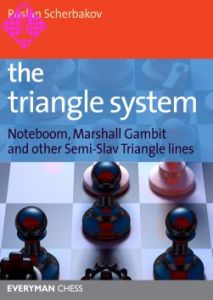 The Triangle System23,95 €
The Triangle System23,95 € -
 Revolution in the 70s (pb)28,50 €
Revolution in the 70s (pb)28,50 € -
 Play the French 4th edition24,50 €
Play the French 4th edition24,50 € -
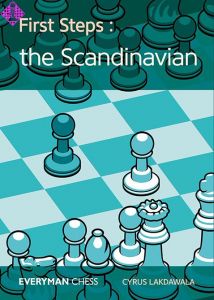 First Steps: The Scandinavian20,95 €
First Steps: The Scandinavian20,95 € -
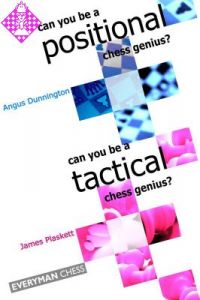 Chess Genius - Compilation21,95 €
Chess Genius - Compilation21,95 € -
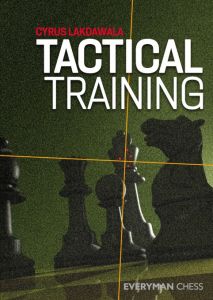 Tactical Training29,50 €
Tactical Training29,50 € - Mehr von Everyman

